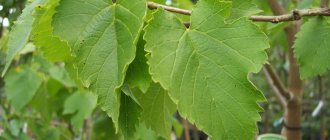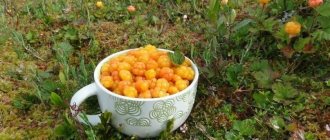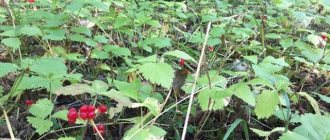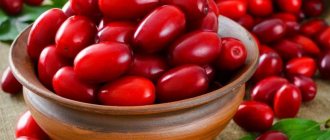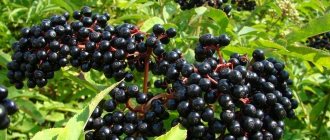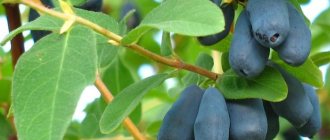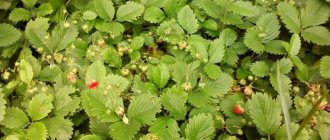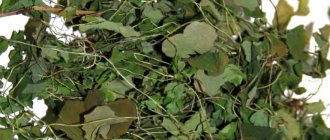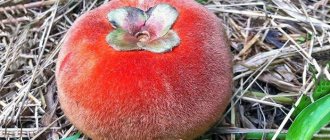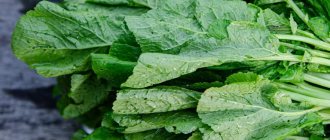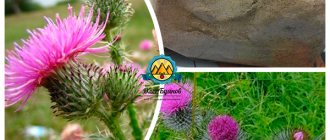Mulberry: plant description
Mulberry is a fairly tall, long-lived tree belonging to the Mulberry family. The minimum age of a mulberry tree is 200 years. The mulberry tree bears edible fruits that vary in color. The length of mulberry berries is 2-3 cm. The taste is sweet and sour, with a pronounced aroma.
- The fruits and leaves of the plant contain large amounts of iron, vitamins B, C and K.
- The plant also contains a rare natural phytoalexin - resveratrol, which has powerful anti-inflammatory properties and the ability to fight cancer cells.
In Russia, the two most common types of plants are white and black mulberries.
Let us dwell in more detail on the properties of each of them.
What does mulberry look like and where does it grow?
The tropical mulberry tree or mulberry is a plant that is cultivated in the southern regions and central zone of Eurasia, in Asian countries, in the subtropics of Africa and North America. There are 17 species of mulberries in the world, but the most famous are the white and black mulberries. Mulberry is directly involved in the process of silk production, so its economic importance cannot be overestimated.
In the mulberry video, you can see that the plant is a medium-height tree with rounded, toothed leaves. Mulberry fruits resemble blackberries in appearance - they are fleshy achenes of black, red or white color, reaching up to 3 cm in length. The taste of mulberries is sweet, with a barely noticeable sourness.
Mulberry in legends
In Germany, mulberry is associated with an evil spirit. The Germans have long believed that the devil polishes his boots with mulberry root.
In ancient Greece, the mulberry was considered a harbinger of unhappy love, and this is due to the legend of Pyramus and Thisbe, who killed themselves with one sword, and their blood colored the mulberry berries crimson.
In China, on the contrary, mulberry symbolizes balance and the union of the feminine and masculine principles. Morus is considered the Tree of Life, which has the power to resist evil; The Chinese transfer the stages of its maturation to human life: birth - maturity - old age and death.
And in Iran and Afghanistan, the mulberry tree is called the “Family Tree” and is planted near almost all houses. According to tradition, the table for family feasts is always placed under the mulberry tree so that evil forces cannot approach it and break family ties.
The ancient Romans firmly believed in the healing power of mulberry, and actively used it as a medicine.
Mulberry: useful information
It is difficult to say which mulberry is healthier: black or white. White, for example, has less calories and has a slightly sour taste. Therefore, it is considered the best product for dietary nutrition, and thanks to ascorbic acid, it improves immunity. Black contains a higher concentration of iron and copes better with gastrointestinal problems.
Regardless of color, ripe mulberries contain large amounts of the natural antioxidant resveratrol. It is this antioxidant that gives red grapes amazing properties, thanks to which red wine is called the elixir of youth. Resveratrol has the ability to lower cholesterol and improve heart function. This component also increases resistance to disease and, as a result, prolongs life.
Thanks to the rich biochemical composition of mulberry:
- activates hematopoiesis;
- normalizes intestinal motility;
- speeds up metabolism;
- maintains hormonal balance;
- tones;
- replenishes energy reserves;
- reduces cholesterol;
- increases libido;
- fights free radicals;
- improves the functioning of the nervous system;
- maintains optimal blood density and clotting;
- supports reproductive function;
- removes fluid from the body and reduces swelling;
- relieves colds and flu;
- prolongs life;
- strengthens the immune system.
The fruits, leaves and bark of mulberry are endowed with many beneficial properties, but there is also a list of contraindications (it is the same for women and men). You should not eat mulberries immediately after meals or with other foods. Sugar in the composition causes increased fermentation, bloating and gas formation.
You should limit your consumption of sweet fruits:
- people suffering from type II diabetes (in case of type I diabetes, they should be excluded completely);
- with a tendency to chronic diarrhea;
- in case of intolerance to components.
A number of cautions apply to mulberries purchased at the market “from hand”. Mulberry trees often grow near large roads, so they accumulate a lot of harmful substances, and the berries become covered with dust. It is difficult to pick berries from tall trees, so fallen fruits are simply collected from roadsides for sale.
In home cosmetology, white mulberries are used, which do not have a coloring pigment. They are crushed and added to tightening masks for oily skin with enlarged pores, and are also used for anti-aging procedures. Brunettes are recommended to rinse their hair with a decoction of dark berries to give it shine and elasticity.
In cooking, jams and jams are prepared from mulberries, compotes and fruit drinks are made. The juice is used to make candies, marmalade, marshmallows, and filling for pies. The berries are fermented to produce homemade wine, and when distilled, vodka-mulberry. Freshly squeezed juice is boiled to a thick viscous syrup and in this way “black honey” bekmez is obtained.
Now the tree is widespread in both temperate climates and tropical regions of the globe. Can live up to 300 years.
In Ukraine, mulberries have been grown since the 16th century. Among the decorative species (there are more than 20 names), white weeping mulberry is popular. It is compact, with a beautiful crown. It is convenient to collect fruits from such a tree. It looks very beautiful in winter next to a pond.
The main part of the mulberry composition is occupied by various vitamins. The concentration of macronutrients in it is slightly lower, while minerals are in last, third place in quantity.
The nutritional value of mulberry is very high, since the tasty berry is extremely healthy and healing for the whole body. Most of the berries contain water and carbohydrates. Mulberries even contain small amounts of dietary fiber, fat and ash.
It is interesting to know that 40% of all vitamins included in the mulberry are water-soluble vitamin C. 10% of minerals are iron, and 8% of the total composition of macroelements is potassium. Mulberries contain only 1% sodium, selenium and zinc.
The main quality indicators and composition characteristics of mulberries may vary depending on the type of fruit. For example, the concentration of sugar (glucose and fructose) in different varieties of berries can range from 9 to 25%.
Mulberries also contain several types of fatty oil. Depending on the variety and concentration, mulberries can contain from 22 to 33%.
All components of the mulberry tree are useful and in demand: leaves and bark, mulberry fruits and their seeds, young buds, roots and wood.
Due to their high taste, mulberry fruits are often used to prepare various dishes and desserts. Mulberry jam and syrup are very tasty and healthy. You can eat both raw berries and boiled or dried ones.
Calorie content per 100 g of berry #8212; 50.4 kcal;
Nutritional value of mulberry: carbohydrates – 12.7 g; proteins – 0.7 g.
Vitamins: A (RE) – 3.3333 mcg, B1 (0.004 mg), B2 (0.002 mg), beta-carotene (20 mcg), C (10 mg), PP (niacin equivalent) – 0.9162 mg, PP (0.8 mg).
Minerals: magnesium, potassium, sodium, calcium.
Mulberries are 82.7% water.
sugar – 20% (sucrose, maltose, glucose, fructose).
The fruits contain citric and malic acids.
The leaves are enriched with: vitamins - riboflavin, nicotinic acid, thiamine, pyridoxineamine, pyridoxine; sterols – capesterol, β-sitosterol; acids #8212; ribonucleic acid, folic acid, fumaric acid, pantothenic acid, palmitic acid; oxycoumarin.
Mulberries also contain the following substances: phenol, methyl salicylate, eugenol, guaiacol. Dried mulberries replace sugar.
Interesting fact: fresh stains on clothes left by black mulberry can be easily removed with the help of unripe green berries, if you mash them well and rub the contaminated areas. A piece of lemon or a solution of citric acid also helps.
The fruits, leaves, and roots of mulberry have medicinal properties.
Berries are useful for people with diabetes. The substances included in its composition are able to regulate blood sugar levels.
An infusion of the leaves works well for this, or you can sprinkle the porridge with small pieces of dried leaves (half a teaspoon per day).
Diabetics can also consume a thick concentrated compote of canned berries without added sugar.
The following ointment, prepared from tree bark, is popular in folk medicine.
Mix 2 tablespoons of pre-dried and ground mulberry bark with 750 ml of vegetable oil. This mixture must be stirred thoroughly. The resulting ointment heals wounds and bruises well.
If you have any allergic reactions, it is also better to stop eating mulberries in any form. Signs of an allergy can be redness, small rashes or itching that seem normal at first glance. If you have such symptoms, it is best not to self-medicate, but to consult a doctor immediately.
Individual intolerance is another negative factor, due to which it is better not to eat dishes with mulberry fruits.
Regardless of the color and variety of berries, in large quantities they can cause acute diarrhea.
Contraindications to mulberry consumption:
- a large number of berries in the heat can increase blood pressure;
- If you have diabetes, you should also eat mulberries in small quantities;
- may cause diarrhea;
- individual intolerance.
The benefits and harms of mulberries is a curious question for fans of home medicine and unusual medicines. Mulberries are not found very often in folk recipes, but when used correctly they can bring enormous benefits.
Mulberry, also known as mulberry, as well as the “king berry” - a tree that reaches 20 meters in height - is widely used in traditional medicine recipes. All parts of this plant have medicinal properties: bark, rhizomes, young buds, leaves and fruits.
Tinctures, decoctions and ointments prepared from mulberry components provide invaluable benefits to our body. But do not forget that the use of mulberries for medicinal purposes also has contraindications.
It is worth familiarizing yourself with them in advance so as not to harm your body.
Mulberry is popularly called the “Tree of Life” for its beneficial properties.
Among the plants there are many in which all parts are medicinal. Mulberry leaves have unique properties. With regular use of decoctions and teas, heart tone and blood pressure are normalized, and the blood is thinned. Dried raw materials are recommended for use for all types of cough, asthma, as an antipyretic and sedative.
Mulberry leaves are heart-shaped or ovoid, similar to blades. The location is different. They look like dark green plates with a shiny surface and a relief mesh of veins. The underside is matte, much lighter. The denticles are clearly visible along the edge of the plate. Mulberry leaf blades are long - from 7 to 15 cm.
The benefits and harms of mulberry leaves lie in the composition. The presence of vitamins and essential oils allows them to be used to treat many diseases.
For various collections, specimens located in the middle tier of branches and on young trees are most suitable. Leaf blades contain:
- carotene and calcium;
- phosphorus and nitrogen;
- protein and fats;
- essential oils that are similar in composition to tea tree oil;
- organic acids;
- a large number of different vitamins;
- ascorbic acid;
- sugar;
- tannins and sterols.
In addition, mulberry leaves are rich in flavonoids (rutin, coumarins, hyperoside and quercetin) and resins.
Important! Mulberries contain active calcium, which is much higher than in cow's milk.
- It is not recommended to consume in large quantities for hypertensive patients with diabetes mellitus.
- Should be used with caution by people predisposed to allergic reactions.
- You should not eat berries on an empty stomach.
- Women expecting a child are not recommended to eat unripe fruits. You also need to observe moderation and not eat more than 1 glass of berries per day. Decoctions and infusions can only be used with the permission of the attending physician.
- When breastfeeding, you should start taking berries with small amounts, observing the baby’s reaction and well-being.
Mulberry: beneficial properties and contraindications
The positive effects of application are expressed by the following types of effects:
- immunostimulating;
- strengthening;
- antidepressant;
- cholesterol-lowering;
- hypoglycemic;
- antioxidant;
- rejuvenating;
- cleansing;
- normalizing (cardiovascular, nervous system);
- improved sleep;
- supporting the functioning of the visual organs;
- increasing the elasticity of capillary walls;
- decreased blood pressure;
- supporting the number of hemoglobin units in the circulatory system;
- prevention of early senile dementia;
- improved brain function;
- diuretic;
- reduction in the amount of fat deposits in internal organs (liver, kidneys);
- antitumor;
- expectorant;
- antitussive.
These effects occur only if the recommended volumes and contraindications are observed.
Mulberry leaves: beneficial properties and contraindications
This part of the plant contains essential oils, resins, phytosterols and other substances that help normalize the amount of glucose/cholesterol in the circulatory system, relieve inflammation, and regulate the functioning of the cardiovascular system.
Indications for the use of freshly squeezed juice from leaves are the presence of:
- bronchial asthma;
- chronic bronchitis;
- non-healing wounds and inflammations;
- inflammatory processes occurring in the oral cavity.
Indications for the use of decoctions and infusions are the presence of diseases/deviations in the functioning of organs such as:
- diabetes;
- hypertension;
- kidney;
- liver;
- gastrointestinal tract;
- anemia;
- acute bronchitis;
- pneumonia;
- bronchial asthma.
Raw materials should be collected in the spring, before the flowers appear. Only young foliage is suitable for use for medicinal purposes, and those collected in other periods have a less rich chemical composition.
It is contraindicated to use decoctions, syrups, infusions prepared on the basis of this part in case of hypotension/hypertension, allergic reactions, individual intolerance.
Mulberry: beneficial properties and contraindications for women
Due to the presence of B vitamins in the chemical composition of the berry, regular use by the weaker sex has an improving effect on the condition of the hair shafts, nail plates, and epidermis. The fact is that a decrease in the concentration of beneficial compounds in the circulatory system leads to the fact that vessels and capillaries do not deliver them to the hair follicles and deep layers of the dermis. This leads to hair loss, fragility, and split ends.
With an increase in the amounts of B vitamins, magnesium, nicotinic acid, copper, zinc in the diet, hair loss decreases, and the epidermis acquires a healthy appearance.
The particular benefit of mulberries for women is determined by the presence of antioxidant compounds in the chemical composition:
- resveratlol;
- tocopherol;
- ascorbic acid.
Free radical reducing agents prevent cancer and also prevent early aging. Polyunsaturated fatty acids have a rejuvenating effect, which slow down the natural decrease in fluid levels in the body.
The leaves contain phytosterols, which normalize hormonal levels, which is important during menopause.
Composition and calorie content of mulberries
Avicenna considered mulberry berries to be a cure for old age, and under Peter the Great, cutting down mulberry trees was punishable by death. The Slavs have always treated this tree with great respect and love. They simply ate juicy sweet berries for pleasure and did not suffer from diabetes, heart disease or anemia.
Bark, leaves, young twigs and ripe fruits are used as medicinal raw materials. The following were found in mulberry berries:
- sugars (up to 20%): maltose, glucose, fructose;
- plant antioxidant resveratrol;
- complex of vitamins: C, E, A, K, PP, B1, B2, B6, B9;
- trace elements: potassium, magnesium, calcium, phosphorus, sodium, zinc, selenium, copper;
- organic and higher acids: malic, citric, folic, pantothenic;
- pectin;
- tannins;
- riboflavin;
- choline
Fatty oils were found in the fruit seeds. The leaves contain thiamine, riboflavin, phenol, eugenol, nicotinic, palmitic and fumaric acids.
The calorie content of berries is 45-50 kcal per 100 g.
The mulberry tree is valued not only because it is an important element in silk production. Mulberries are of great medical importance. They include:
- organic acids and vegetable sugars;
- ash and fiber;
- vitamins A and C;
- vitamin B1 and beta-carotene;
- vitamin PP;
- mineral components potassium and magnesium, sodium and calcium;
- folic and pantothenic acids.
The calorie content of mulberry berries is 53 calories per 100 g of fresh product.
Contraindications
The fruits, leaves and bark of mulberry are endowed with many beneficial properties, but there is also a list of contraindications (it is the same for women and men). You should not eat mulberries immediately after meals or with other foods. Sugar in the composition causes increased fermentation, bloating and gas formation.
Read also: What does it mean to give yellow roses?
You should limit your consumption of sweet fruits:
- people suffering from type II diabetes (in case of type I diabetes, they should be excluded completely);
- with a tendency to chronic diarrhea;
- in case of intolerance to components.
A number of cautions apply to mulberries purchased at the market “from hand”. Mulberry trees often grow near large roads, so they accumulate a lot of harmful substances, and the berries become covered with dust. It is difficult to pick berries from tall trees, so fallen fruits are simply collected from roadsides for sale. It is simply impossible to thoroughly wash soft berries, so you should buy mulberries only from trusted suppliers or harvest them yourself.
Mulberry leaves: properties, benefits and harms, recipes
- Helps in the treatment of diseases of the respiratory system.
- Eliminates symptoms of colds.
- Fights pancreatic diseases.
- Used to treat inflammatory eye diseases, such as conjunctivitis.
- Normalizes blood pressure and strengthens the walls of blood vessels.
- Used as a hair rinse.
- 1-2 teaspoons dried leaves.
- 300 ml hot water.
Tea should be brewed in porcelain or ceramic containers. Brewing time is from 2 to 5 minutes. Number of brewings of the same raw material: 2-3 times.
You should not drink more than 2 cups of mulberry leaf tea per day; its benefits are, of course, undeniable, but harm from exceeding the dose is inevitable.
Thanks to this composition, plant components have antiseptic, diuretic, diaphoretic, sedative, astringent, expectorant, and antioxidant effects.
However, you should not immediately rush to this tree and consume its gifts in large quantities. This is due to the fact that their excessive consumption contributes to the development of digestive disorders. People suffering from diabetes and hypertension should also use mulberries with caution. The best option would be a preliminary consultation with a doctor.
White berry juice is an excellent medicine to fight colds. To do this, you need to drink 100 milliliters every 3 hours. This technique allows you to alleviate the symptoms of the disease, lower the temperature, and strengthen the immune system.
Black mulberry is recommended for food poisoning. In the body it has a disinfecting effect. Unripe black berries can be used as a remedy for heartburn, and overripe ones can be used instead of laxatives. You can normalize sleep, strengthen the nervous system, and overcome insomnia by consuming a glass of ripe fruits with a spoonful of your favorite honey a couple of hours before bedtime.
You can overcome stomatitis, periodontal disease, ulcers and throat pathologies with the help of mulberry infusion. To do this, you need to pour 2 tablespoons of ground berries with 200 grams of boiling water.
Mulberry fruits also have a beneficial effect on the body when:
- heart disease;
- tachycardia;
- disruptions in metabolic function;
- ischemia;
- obesity;
- atherosclerosis;
- dystrophic process in the heart.
This video talks about the beneficial properties of mulberries.
Tree leaves
The leaves of the plant also have many beneficial properties. Dried raw materials are usually used for treatment, as they are much easier to store. Mulberry leaf decoctions are used:
- if necessary, wash open wounds;
- for sore throat, the decoction is used as a rinse solution;
- to block swelling processes, you need to drink the product a couple of hours before bedtime;
- as an expectorant to help cope with bronchitis and pneumonia - you need to take the drug 50 milliliters 3 times a day before meals.
This healing decoction is prepared quickly and simply, just follow the 3-step technology: A dinner spoon of crushed mulberry leaves is immersed in a clean container. The raw materials are poured with half a liter of water, and then put on fire. After the liquid reaches a boil, the container should be closed and the drink allowed to brew half an hour. After this, the liquid must be filtered.
A decoction can be prepared from the root of the mulberry tree, which helps normalize blood pressure, as well as the function of the circulatory system. A healing decoction is prepared using the following technology:
- 50 grams of raw materials are crushed using a coffee grinder or blender.
- The resulting slurry is poured with 1 liter of hot water.
- The liquid is infused for 60 minutes, and then the container is placed on low heat.
- The drink is brewed for a quarter of an hour, and then cooled to room temperature, filtered through a fine sieve or cheesecloth.
You can drink the resulting drink 1/3 glass 3 times a day. To improve the taste, you can dissolve a dessert spoon of any honey in the broth.
This decoction can also reduce blood sugar levels in people suffering from type 2 diabetes. White mulberry raw materials will be especially effective in this case. And by mixing crushed tree root bark with vegetable oil, you can get an excellent remedy for treating ulcers in diabetes mellitus.
Mulberry is a unique plant that has a beneficial effect on the human body, but before using it for medical purposes, it is better to consult a physician. This is due to the fact that mulberry raw material is a strong allergen, which can only be consumed in small quantities by those people who do not have an individual intolerance to this plant.
Mulberry leaves: properties, benefits and harms, recipes
The healing properties of mulberry are used to treat a number of diseases. In home medicine there are many proven recipes that alleviate the symptoms of ailments.
Mulberries contain all the beneficial substances necessary for healthy cardiac and vascular function. The benefits of mulberry leaf tea are useful for strengthening blood vessels, purifying the blood, normalizing blood pressure and improving heart rate.
The tea is made like this: pour boiling water over 2 large spoons of crushed leaves, cover with a lid and leave for 20 minutes. Drink the drink a couple of cups a day before meals, and the benefits of mulberry tea will be greater if you do not add sugar to it.
For anemia
The properties of dried mulberry or plant bark will help improve blood composition and restore vigor and physical strength. To prepare a healthy infusion, pour 1 teaspoon of crushed dry bark or a handful of berries with a glass of boiling water, then cover with a lid and leave for an hour.
You need to drink the infusion little by little - just 1 large spoon three times a day before meals.
For coughs and colds
For ARVI and influenza, mulberry tincture is beneficial - 2 cups of fresh berries are poured into 500 ml of vodka, 200 g of sugar are added and kept in a dark place for 20 days, periodically shaking the closed vessel. When consumed, the tincture not only quickly reduces the temperature, but also has a mucolytic effect on dry cough.
Attention! Since the tincture contains alcohol, you can use mulberry for coughs and colds in an amount of no more than 3 teaspoons per day, otherwise it will be harmful.
Mulberry can be used for nasal congestion. Fresh juice obtained from berries is instilled into the nose, 2-4 drops up to 6 times a day.
For cataracts
Cataracts are a dangerous eye disease that can lead to complete blindness. The beneficial properties of mulberry leaves will help prevent the development of the disease.
- 2 large spoons of fresh or dry leaves, crushed.
- Pour 500 ml of boiling water and cook for a quarter of an hour.
- Leave covered for another hour and then strain.
Drink the remedy twice a day, in the mornings and evenings. To achieve the effect, you need to use the decoction daily for 1-3 months, and then take a break.
For headaches
The healing properties of mulberry help get rid of migraines. You need to take a handful of crushed bark or roots of the plant and pour 1 liter of boiling water, and then boil for 10 minutes.
The drink is infused for another hour, then filtered, and then taken 1 glass three times a day for 2 months. The properties of mulberry root and plant bark strengthen blood vessels and normalize blood pressure, so headaches recede.
For pancreatitis
In case of acute pancreatitis, most products are strictly prohibited for consumption, and taking mulberry during periods of severe pain is also not worth it, it will cause harm. However, during the period of remission, mulberries will be of great benefit, as they will improve digestion and support the functions of the pancreas.
For pancreatitis, mulberries can be consumed in the form of compotes; dried mulberries will be beneficial. You can consume decoctions and infusions of berries before meals to facilitate the digestive process.
For diabetes
The benefit of mulberry for diabetes is that the plant contains a large amount of riboflavin and regulates blood sugar levels. Mulberry is especially recommended for use in type 2 diabetes.
For this disease, you can eat mulberry berries, or you can take a healthy infusion.
- 2 large spoons of dried berries are crushed and poured with a glass of boiling water.
- Leave for 4 hours.
- Strain through cheesecloth and drink several sips throughout the day.
Advice! It is not recommended to drink regular tea at the same time as mulberry infusion - the tannins present in it neutralize the effect of the beneficial components of mulberry.
At high temperatures, a weak, weak infusion of mulberries helps well. Several fruits are stirred with sugar, poured with warm water, stirred again and drunk until the temperature drops. By the way, the benefits of dried mulberries are no less than fresh ones.
For edema
An infusion of fresh mulberries will improve kidney function and help get rid of swelling.
- 2 large spoons of berries are thoroughly kneaded.
- Pour a glass of boiling water and cover with a lid.
- Leave for 4 hours and then strain.
In order not to cause unnecessary harm to the kidneys, you need to drink the medicine four times a day, half a glass.
From worms
Mulberry is an effective home remedy for deworming. It is very simple to prepare a medicinal infusion; you just need to pour boiling water over a few fresh leaves of the plant or its crushed twigs. The product is infused for several hours, and then drunk in the morning and evening, half a glass before eating.
The strengthening properties of mulberry are used, among other things, externally for burns and wounds, psoriasis and dermatitis, ulcers and eczema.
- Take 2 large spoons of dry crushed plant bark.
- Pour in 100 ml of pre-boiled sunflower oil.
- Leave in the refrigerator for 3 days.
The prepared thick product is applied to the affected areas of the skin several times a day or medicinal compresses are applied for a couple of hours.
The following mulberry remedy will help improve the condition of the eyes, relieve them of chronic fatigue and eliminate tearing:
- A handful of dry leaves of the plant are poured with 1 glass of water;
- Keep in a water bath for 10 minutes;
- Then cool and instill 5 drops into each eye daily.
The warm leaves remaining in the decoction can be placed on your eyelids for a quarter of an hour immediately after preparing it.
